Jul 7, 2020
Do I need a new dock?
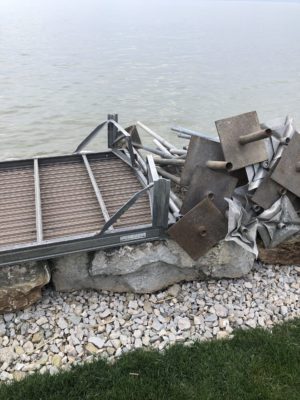
Do I NEED A NEW DOCK?
Docks that are several years old will show some signs of wear. It might be the decking, or it could be the frames. Either way, your dock needs yearly inspections. It’s especially true this year.
Why? You guessed it – the storms. At least two things are happening. Record-setting water levels mean the waves can dislodge trees, logs, and other floating objects that have been sitting dormant on the shore for years. They get washed along the beaches and could hit your dock or boat lift during a storm.
Other docks or decking from your neighbors’ pier can be washed out too. That debris could also hit your dock. Don’t forget about the jet skis and boats that get dislodged in the significant storms.
How many times does it take to cause damage to a dock or boat lift?

Dock damage
Once could be enough. Imagine a boat or log floating under your dock or into your boat lift. The next wave pushes it up against the bottom of your dock or lift. With the wood hung up under the frames, they get twisted by the waves. Here’s the result.
Is the hardware still holding tight?
At one point, at least one manufacturer’s decking was glued and stapled. This decking did not have enough support under the decking, either. The constant flexing of the panels and the natural wood shrinkage meant the staples loosened, and the glue let go.
Consider replacing a wooden decked pier with a different material. If the frames are sound, you may be able to use the Flow-through decking options.
Flow-Through decking is considered the best decking available. For more information, click HERE.
What about the frames?
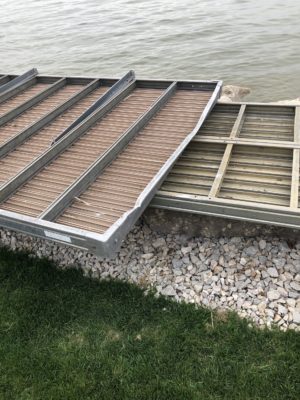
Is your dock frame bent?
How much wear and tear is the question. Proper maintenance of a dock system can help keep it looking beautiful for a long time. Some types of damage are easily repaired. Others need a lot of work.
But, if your dock is getting dangerous and unreliable, replacement might be the best option. Here are some more signs that you should think about investing in a brand new dock.
Widespread Rust
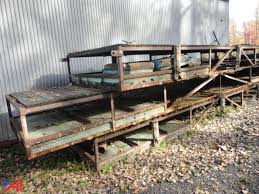
Do I need a new dock?
Certain types of metal used around water will rust. Painted, and even powder-coated metals will need regular upkeep to keep ahead of the rust.
Large areas of rust will spread. They eat away at the dock frames. If the metal rusts through, it can cause breakage in other areas too.
In cases like this, a completely new dock might be necessary.
Aluminum docks are made of rustproof metal and are a great option when considering upgrading or replacing a failing dock.
Have wood – will rot, Discolor, Split … You get the point!
Wooden docks can rot when water seeps into the wood. Moss, mildew, algae, and other growth can trap moisture in the wood decking, worsening the situation. However, it can be solved or prevented by keeping your dock clean and well maintained.
If a small area is experiencing rot, replace the individual components with new, treated lumber. But, when multiple areas are rotting, it’s time to replace your dock.
Consider replacing a wooden pier with different materials, including aluminum painted to look like wood, which is one of the premium ShoreMaster decking options.
Cracked or Warping Dock Supports
Has any boat come in “hot” (too fast) and hit the frames or vertical supports? Maybe a wave pushed your boat faster than expected or in the wrong direction. Accidents happen!
While the damage may appear only superficial, it’s essential to check all the welds in the immediate area.
Don’t let this type of damage go unattended. With the current rash of storms and high water, this type of damage can quickly become critical.
Minor cracks in small areas may require welding or the replacement of some parts. If major load-bearing areas have significant damage, it’s better to stay safe and replace the structure.
Can a permanent dock be damaged?
Permanent docks sit on large pipes or underdeck support systems. Assessing the damage below the waterline, let alone repairing it, requires specialized equipment.
Dock foundations are subject to:
- Water movement,
- Changing temperatures,
- Currents,
- Ice movement, and
- Other factors that can cause foundation shifts and severe damage.
Cracking is a sign that further investigation and possibly replacement of your docking system will be needed.
Posts Can’t Be Set Properly?
Permanent boat docking systems have supports to hold them up. In some instances, the support pipes must be driven up to 100 feet deep at times to find the solid rock. Even then, winter ice can grip the outside of the post and raise it again.
If the ice raises your posts, it might be time to replace your dock. Look into a floating aluminum or steel dock that adapts to fluctuating water conditions. This type of dock can be removed in winter or protected by a “de-icer” system. The “de-icer” system prevents the ice from locking onto the pipes and being drawn back up.
Custom Docking Systems – Pier & Waterfront Solutions
If it’s time to replace or upgrade your boat docking system, PWS can help. We are the experts in the waterfront business. We have helped many shoreline owners find their perfect waterfront solution – it’s written right into our name.
Did you know PWS has new and used aluminum or steel docks and lifts available? We also have the New 3-Season Pier (steel) for the roughest of waters.
Need an entirely new aluminum dock system or the perfect accessory? Pier & Waterfront Solutions has a support team that can help.
Remember, Pier & Waterfront Solutions (PWS) specializes in Waterfront Solutions for docks and lifts.
For more information and what works best for your area, contact Jerry @ (920) 493-4404 TODAY – or – fill out this simple quote request form.
Where is Pier & Waterfront Solutions?
Located at 7325 St. Hwy 57, it’s 3 miles south of Sturgeon Bay, and 1 mile past the intersection of Cty MM (heading north). Look on the right side, one mile north, at the next intersection (Idlewild Road and Hwy 57).
ARE WE OPEN?
During this time of uncertainty, Pier & Waterfront Solutions has stayed “open.” We have implemented measures to ensure the safety of our employees and visitors. At the same time, we are working to maintain the trusted service that you have come to expect.
We are conducting as much business as possible by email, text, or phone. Site visits will continue as usual. When in-person contacts are necessary, we will follow “social distancing” guidelines.
Our display yard is always open for you to examine at your leisure. All displays have a numbered, red tag on them. If you want more information or pricing, please reference that number.
We provide estimates and invoices by email to make the process paperless and faster. With these measures, we hope everyone will stay safe, and we will be back to normal operations soon.
What can YOU do to help us?
Please conduct as much business as possible via emails, messaging, and emails. When you see our crews installing equipment, please practice “social distancing.”
Please call, message, or email us with any questions.
Thank you for allowing us to work with you.
Let’s all stay safe!
Apr 24, 2020
The Ultimate Guide to Dock Sway
Define Dock Sway
Dock sway is the side-to-side movement experienced when you walk on dock decking. The higher a dock sits, the more likely it will occur. It can also happen on deeper inland akes, even though the deck is only a foot above the water. Sway is the direct result of the length of the legs and the size of the leg material.
We have published several articles to tell you about the continued rising waters on Green Bay and Lake Michigan.
https://wisconsinpws.com/rip-rap/ &
https://wisconsinpws.com/lake-michigan-water-levels/)
At the time of the most recent report, the water was 14″ higher than last year. Remember, last year was about 12″ higher than the previous year.
Since the most recent update, it has continued to rise several inches more. The upward trend will continue through 2020.
How Much Higher Will the Docks be This Year?
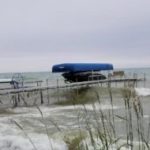
Long legs = dock sway
It will be necessary to raise the docks to adjust for storms. It’s the only way to escape the waves’ energy. The high waves we experience in Door County means it is always prudent to raise the dock accordingly.
What Causes Dock Sway?
The longer the legs are, the more likely you are to experience sway. Let’s look at two examples to explain this:
- A flagpole tends to sway when subjected to strong winds. If you raise the pole 10′ higher without increasing the diameter of the flagpole, you will see much more sway. The higher the pole is, the larger the width of the pole must be.
- If you step on a 6-foot step ladder, the first few rungs are pretty stable. You’re not high off the bottom. The higher you go, the more the ladder tends to sway.
We do not advise this, but if you place your feet on the top rung of the ladder, you need to start looking for a safe place to land.
How Can You Minimize Sway?
There are several things that you can do:
1. Increase the width of the dock. It’s more stable when walking on a wider pier. But, that’s not practical when you already have a dock.
2. The addition of cross-braces on the lower parts of the legs will reduce the swaying motion. Cross braces are rigid pipe(s) attached in an “X” pattern to make the dock stable. Usually, the cross brace attaches near the end of the dock, where the longest legs are used. The end is the most susceptible point on a pier when looking at sway.
3. New this year is the 3-Season Pier. This new pier will also be set high, but the legs are stronger (larger diameter), and the dock is more stable as a result. Cross braces would still be a good idea if your experience sway.
4. Give serious consideration to not installing all the sections you have available. See this article – Shorter Dock on April 28th.
Why Go Through Any of These Expenses?
You could let the waves destroy the dock and get a new one using the insurance money. Wrong!! If you re thinking this way, check out this article along with this article. Insurance will rarely pay for your damaged dock.
What Does the 3-Season Pier Use?
On the 3-Season Pier, we use 2″ schedule 40, galvanized steel pipe, which has an outside diameter of 2 3/8″.
Compare that with the legs used by some competitors, which are 1 ¼” pipe or even 1 ½” tubing. (Tubing is the lightest or thinnest of all the materials used. Tubing is used mainly on all-wood docks). Both of these have little strength, and docks should never use them.
One Last Suggestion
One final recommendation is to use “Flow-Through” decking (see this article on May 19th) This decking minimizes the effects of the waves on the dock. With 42% less deck surface, it allows much of the wave’s energy to pass harmlessly through the decking.
In conclusion
Give serious consideration to not installing the full length of your dock to avoid sway this year.
Tell Your Friends & Family
Have friends or neighbors you believe should see this article? Email them this link – and Thank you!
Also, visit Pier & Waterfront Solutions on Facebook.
Don’t Forget – Considering rip-rap for your shoreline? PWS is the place to contact!
Where is Pier & Waterfront Solutions?
Located at 7325 St. Hwy 57, it’s 3 miles south of Sturgeon Bay, and 1 mile past the intersection of Cty MM (heading north). Look on the right side, one mile north, at the next intersection (Idlewild Road and Hwy 57).
ARE WE OPEN?
During this time of uncertainty, Pier & Waterfront Solutions is staying “open.” We have implemented measures to ensure the safety of our employees and visitors. At the same time, we are working to maintain the trusted service that you have come to expect.
We are implementing these precautionary measures:
- Conducting as much business as possible by email, text, or phone.
- Site visits will continue but with limited in-person meetings.
- When in-person contacts are necessary, we will follow “social distancing” guidelines.
- Our display yard is always open for you to examine at your leisure. All displays have a numbered, red tag on them. If you want more information or pricing, please reference that number.
Is there More?
- Some employees will be working remotely, but they are always available by phone.
- Any employee with symptoms or illness is sent home.
- We continue to provide estimates and invoices by email to make the process paperless.
- Crew starting times are being staggered to limit social interactions.
- We keep the same crews together to limit cross interactions.
With these measures, we hope everyone will stay safe, and we will be back to normal operations soon.
What can YOU do to help us?
- Please conduct as much business as possible via emails, messaging, and emails. This step protects everyone involved.
- When you see our crews installing equipment, please practice “social distancing.”
Thank you for allowing us to work with you.
So – YES – WE ARE OPEN!
Please call, message, or email us with any questions.
Let’s all stay safe!
Contact:
Jerry @ (920) 493-4404 or Jerry@wisconsinpws.com – Commercial work & new/used Sales.
Dave @ (920) 905-2588 or Dave@wisconsinpws.com – Erosion control & shoreline work.
John @ (920) 493-4405 or John@wisconsinpws.com – Scheduling & Service work
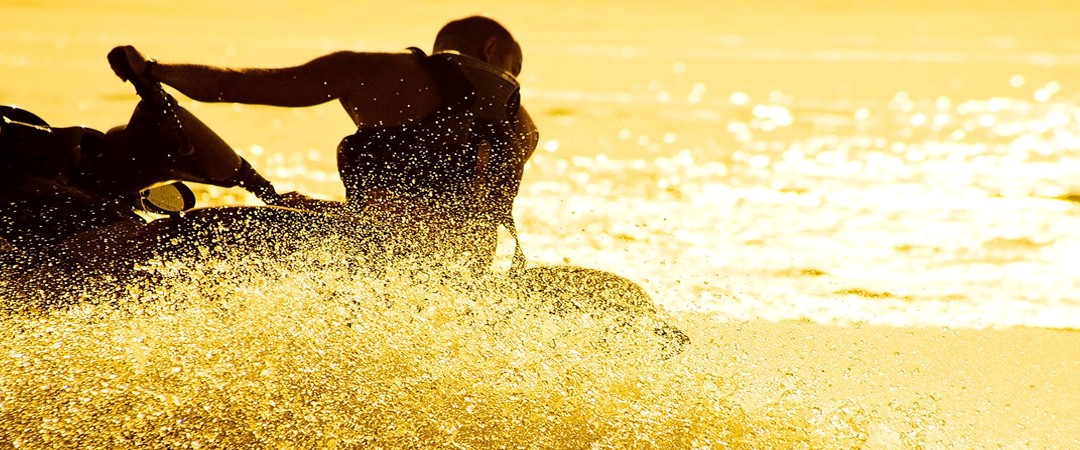
Jul 16, 2019
Are there different Styles?
Yes, they come in two styles: Stand-Ups and Sit-Downs.
Both styles use water to create thrust to provide propulsion. The propulsion also controls the steering. Therefore, the motor has to be running to use either or both features.
Stand-up jet skis require a great deal of balance as any experienced operator will tell you. I suggest that your first jet ski ride happens on a sit-down unit.
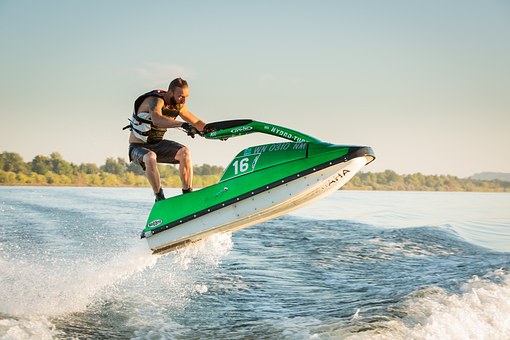
Stand-up PWC
Stand-ups are not easy to control, and a strong wave can easily throw you off balance. That means you are going for a swim, whether you want to or not!
You have greater control on a sit-down from a slow idle to full speed ahead. The sit-down type is more comfortable to ride, and, if maneuvered correctly, you don’t even have to get wet! But who wants that! The wetter you are, the better.
Before your first trip on a PWC (here comes the checklist)
Jet ski riders do get injured; which makes it important to familiarize yourself with the specific watercraft you’ll be riding.
Injuries?? From what?! How about getting thrown off your ride for one. It’s very easy to do when you are turning at full speed. It’s exciting also.
Despite this, safety should be your first concern – both for you, your passenger, and people in the immediate area.
Know your machine’s controls and capabilities! Know your abilities as well. Different brands will have different controls, so make sure you know what’s the throttle and what’s the emergency shut off. Throwing the wrong switch could be very embarrassing (and dangerous).
Make sure you have enough fuel and all the proper safety equipment too.
My First Jet Ski Ride – what do I need to take with me?
The U.S. Coast Guard considers a PWC to be a Class A vessels. Therefore you must follow all rules and regulations for boats under 16 feet. Before that ride, make sure you have the required safety equipment. Not only to satisfy the Coast Guard but for your own safety as well.

Boat Safety Rule #1- Everyone needs one
Wear Coast Guard-approved life jackets/PFDs at all times. It’s a law that you and passengers can live with! Dress appropriately in a wetsuit, if possible. Wear simple feet protection and don’t forget eye protection. In most cases, your face will be pelted with stinging water while on your ride.
Check if your state requires a license while operating a PWC. If so, you may have to take a jet ski safety course to qualify for your license. The course may make you eligible for a PWC insurance discount too! Carry the proper documentation, such as vessel registration. It’s wise to have some form of identification also in case you are incapable of responding.
Secure a Coast Guard-approved fire extinguisher onboard if possible.
What else should I have?
Carry an audible signaling device, such as a whistle or horn. Don’t forget to check your fuel gauge. You will forget the time (a good thing for most of us) but bad if you run out of daylight or fuel! The driver of the jet ski must wear a lanyard around their wrist, which is attached to the key in the ignition. It’s known as a kill switch cord. The kill switch will turn off the engine in case the driver gets thrown off the unit. Some models may shut down if the throttle is released (as you go flying through the air).
Back at the dock, don’t forget to remove the cord! It stops any unauthorized use, whether preventing theft or safely securing the jet ski from daring young teenage riders.
What do I do if I fall off?
No doubt you will fall off, so here’s what you do.
Don’t panic. Re-boarding is a breeze if you follow these steps!
1. Turn the unit over from the side but watch the steering. It might hit you if you’re not careful.
2. Swim to the stern (back) to re-board. Re-boarding from the side may cause the unit to flip over, right on top of you.
3. There are handles or straps on the back of the seat. Use them to pull yourself up.
4. Move forward to the seat and don’t forget to re-attach the safety lanyard.
5. Of course, you were wearing a life preserver all this time.
Riding a Jet Ski with Passengers
It’s no surprise you will become very popular with your friends and family. They all want to ride on, or better yet, drive it themselves. If so, there are some extra steps to follow:
Carry only the permitted number of passengers that the jet ski allows. Don’t pile the kids on even for a slow speed ride. Make everyone wait their turn. Don’t forget there is a weight limit also. You must follow that limit.
All passengers must sit behind the driver.
Whenever the jet ski’s moving, have passengers secure themselves onto the seat straps provided. They will be the first to get thrown off the unit in a sharp turn at high speeds.
Make sure no one places their feet in the water while you are moving.
Demonstrate the basics of driving a jet-ski to all passenger’s. Why? If the driver becomes injured, it could come in handy! Make sure they know how to re-board if they are thrown off and you are injured.
Lookout for blindspots while turning.
Riding jet skis is a fun-filled summer pastime, but only if you do it correctly and safely. It takes practice. With practice, you’ll be ready when your time comes.
Be safe but have fun. Get out there and ride!
Next week we will talk about jet skis and THE LAW! https://wisconsinpws.com/jet-skis-the-law/
Do you have a friend that might be interested in this post? Please forward it to them.
Pier & Waterfront Solutions
PWS is located at 7325 St. Hwy 57. That’s 1 mile North of County MM (Hwy 42) and 3 miles South of Sturgeon Bay at the Idlewild Road intersection. Or – for more information, you can call Jerry @ 920-493-4404.

Jul 2, 2019
JULY 4 th IS ALMOST HERE
July 4 th is something we all look forward to each year. There are fireworks, family reunions, and making new friends.

Making a new friend on July 4 th
This year we especially look forward to the four day weekend it brings with it. If Mother Nature cooperates with us, it should be a great weekend.
July 4 th Door County Happenings
Check this article out for a list of July 4 th activities.
However, let’s not forget what July 4th also brings with it. Generally, the boat traffic is substantial all through the weekend. There will be lots of water skiing and boating going on. Not to mention the parties.
Safety Tips
Some safety tips that we must all be aware of are:
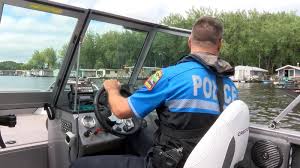
Boat Safety Rule #3- Don’t get a visit from him
1. Choose a designated driver. It’s not just for cars. The DNR and law enforcement will be out in force trying to protect you.
2. Don’t allow anyone under the influence to swim alone.
3. Be especially mindful of kids. That means your kids or grandkids and also the neighbors. Kids know no boundaries.
4. Fireworks on boats are a real danger. You have fuel and many flammable items on a boat. Besides, people are in close proximity even a pontoon boat. Leave the fireworks to the professionals.
5. The weather to date has been colder than average, and many of the trees are way behind. Did you know, if you are in an area where there are poplar trees, and you see those fuzzy white balls floating in the air and clinging to your lawn, they present danger around camp-fires and fireworks?
How can something so lightweight and harmless be a danger? The author was at campground years back with the ground covered by the fuzz. Someone threw a firecracker on the ground, and the resulting flash instantly caused a fire that moved incredibly fast. Everyone at the campground had to fight the fast-moving flames. It swept rapidly in every direction.
6. Did you know that, in general, the same rules apply when operating a boat as operating a vehicle? You can receive a citation for following too closely, racing a boat or jet ski too closely, driving under the influence, making dangerous maneuvers, not having the proper life preservers (just like a seatbelt), and more.
MANY MORE IDEAS
We could go on and on but if you want more information about safety, consider reading this article. Here are some more 4th of July tips.
We frequently stress safety because it only takes a snap of your fingers for an accident to happen. We don’t want your weekend (or life) ruined by one wrong decision.
Have a safe and enjoyable July 4th holiday
Where can you find Pier & Waterfront Solutions?
We are located in the center of the Door County Peninsula at 7325 St. Hwy 42/57. That’s 1 mile North of County MM (Hwy 42) and 3 miles South of Sturgeon Bay. Look for the Idlewild Road intersection.
Don’t forget – Give us a call If you have a dock or boatlift topic you would like to see addressed on our site.
Call Jerry at 920-493-4404 or Email Jerry@wisconsinpws.com for more information.
Feb 8, 2019
We really appreciate your help & working with you on our dock!
Sally S. Door County WI
















